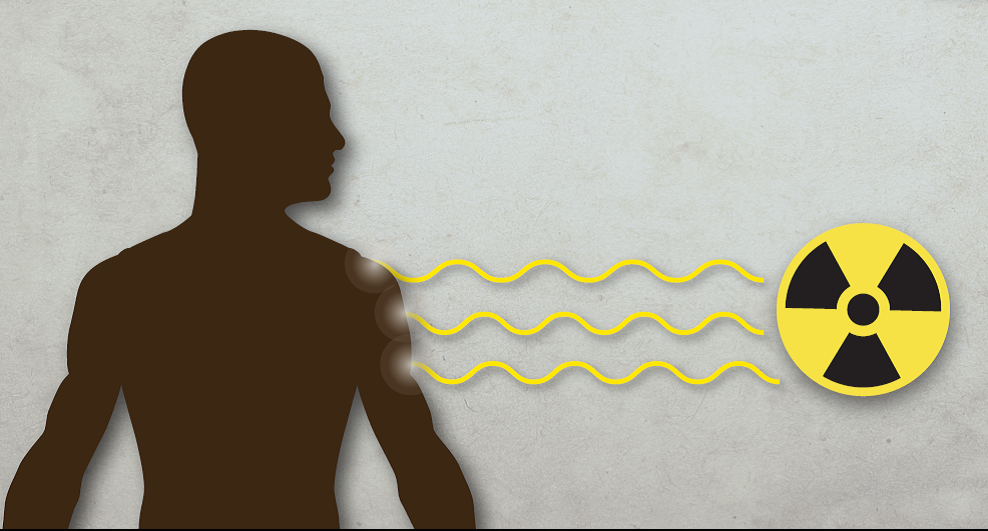Ionizing radiation refers to a type of radiation that has enough energy to remove tightly bound electrons from atoms, resulting in the formation of ions (atoms with a net electrical charge). This form of radiation can have harmful effects on living organisms, including humans, when they are exposed to it. Here are some of the key health effects of ionizing radiation:

Key facts
- Ionizing radiation is a type of energy released by atoms in the form of electromagnetic waves or particles.
- People are exposed to natural sources of ionizing radiation, such as in soil, water, and vegetation, as well as in human-made sources, such as x-rays in medical devices.
- Ionizing radiation has many beneficial applications, including uses in medicine, industry, agriculture and research.
- As the use of ionizing radiation increases, so does the potential for health hazards if not properly used or contained.
- Acute health effects such as skin burns or acute radiation syndrome can occur when doses of radiation exceed very high levels.
- Low doses of ionizing radiation can increase the risk of longer term effects such as cancer.
What is ionizing radiation?
Ionizing radiation is a type of energy released by atoms that travels in the form of electromagnetic waves (gamma or X-rays) or particles (neutrons, beta or alpha). The spontaneous disintegration of atoms is called radioactivity, and the excess energy emitted is a form of ionizing radiation. Unstable elements which disintegrate and emit ionizing radiation are called radionuclides.
The activity — used as a measure of the amount of a radionuclide present — is expressed in a unit called the becquerel (Bq): one becquerel is one disintegration per second. The half-life is the time required for the activity of a radionuclide to decrease by decay to half of its initial value. The half-life of a radioactive element is the time that it takes for one half of its atoms to disintegrate. This can range from a mere fraction of a second to millions of years (e.g. iodine-131 has a half-life of 8 days while carbon-14 has a half-life of 5730 years).
Radiation sources
People are exposed to natural radiation sources as well as human-made sources on a daily basis. Natural radiation comes from many sources including more than 60 naturally-occurring radioactive materials found in soil, water and air. Radon, a naturally-occurring gas, emanates from rock and soil and is the main source of natural radiation. Every day, people inhale and ingest radionuclides from air, food and water.
People are also exposed to natural radiation from cosmic rays, particularly at high altitude. On average, 80% of the annual dose of background radiation that a person receives is due to naturally occurring terrestrial and cosmic radiation sources. Background radiation levels vary geographically due to geological differences. Exposure in certain areas can be more than 200 times higher than the global average.
Exposure to radiation also comes from human-made sources ranging from nuclear power generation to medical uses of radiation for diagnosis or treatment. Today, the most common human-made sources of ionizing radiation are medical devices, including x-ray machines and Computed Tomography (CT) scanners.
Exposure to ionizing radiation
Exposure to radiation may occur through internal or external pathways.
Internal exposure to ionizing radiation occurs when a radionuclide is inhaled, ingested or otherwise enters into the bloodstream (for example, by injection or through wounds). Internal exposure stops when the radionuclide is eliminated from the body, either spontaneously (such as through excreta) or as a result of a treatment.
Exposure to ionizing radiation can be classified for radiation protection purposes into three exposure situations, i.e. planned, existing and emergency situations. Planned exposure situations result from the deliberate introduction and operation of radiation sources with specific purposes, as is the case with the medical use of radiation for diagnosis or treatment of patients, or the use of radiation in industry or research. Existing exposure occurs where radiation already exists and a decision on control must be taken – for example, exposure to radon in homes or workplaces or exposure to natural background radiation from the environment. Emergency exposure situations result from unexpected events requiring prompt response, such as nuclear accidents or malicious acts.
Medical use of radiation accounts for 98 % of the population dose contribution from all human-made sources, and represents 20% of the total population exposure. Annually worldwide, more than 4200 million diagnostic radiology examinations are performed, 40 million nuclear medicine procedures are carried out, and 8.5 million radiotherapy treatments are given.
Health effects of ionizing radiation
Radiation damage to tissue and/or organs depends on the dose of radiation received, or the absorbed dose which is expressed in a unit called the gray (Gy). The potential damage from an absorbed dose depends on the type of radiation and the sensitivity of the different tissues and organs.
The effective dose is used to measure ionizing radiation in terms of the potential for causing harm. The sievert (Sv) is the unit of effective dose that takes into account the type of radiation and sensitivity of tissues and organs. It is a way to measure ionizing radiation in terms of the potential for causing harm. In addition to the amount of radiation (dose), the rate at which the dose is delivered (dose rate), described in microsieverts per hour (μSv/hour) or millisievert per year (mSv/year), is an important parameter.
Beyond certain thresholds, radiation can impair the functioning of tissues and/or organs and can produce acute effects such as skin redness, hair loss, radiation burns, or acute radiation syndrome. These effects are more severe at higher doses and higher dose rates. For instance, the dose threshold for acute radiation syndrome is about 1 Sv (1000 mSv).
If the radiation dose is low and/or it is delivered over a long period of time (low dose rate), the risk is substantially low because there is a greater likelihood of repairing the damage. There is still a risk of long-term effects such as cataract or cancer, however, that may appear years or even decades later. Effects of this type will not always occur, but their likelihood is proportional to the radiation dose. This risk is higher for children and adolescents as they are significantly more sensitive to radiation exposure than adults.
Epidemiological studies on populations exposed to radiation, such as the survivors of the atomic bombings or radiotherapy patients, showed a significant increase of cancer risk at doses above 100 mSv. More recently, some epidemiological studies in individuals exposed to medical exposure during childhood (paediatric CT) have suggested that cancer risk may increase even at lower doses (between 50-100 mSv).
Prenatal exposure to ionizing radiation may induce brain damage in foetuses following an acute dose exceeding 100 mSv between weeks 8-15 of pregnancy and 200 mSv between weeks 16-25 of pregnancy. Before week 8 or after week 25 of pregnancy human studies have not shown radiation risk to fetal brain development. Epidemiological studies indicate that the cancer risk after fetal exposure to radiation is similar to the risk after exposure in early childhood.
WHO response
WHO works to strengthen radiation protection of patients, workers and the public worldwide. It provides Member States with evidence-based guidance, tools and technical advice on public health issues related to ionizing radiation. Focusing on public health aspects of radiation protection, WHO covers activities related to radiation risk assessment, management and communication.
In line with its core function on “setting norms and standards and promoting and monitoring their implementation”, WHO contributed to the development, co-sponsored and endorsed the latest version of the International Basic Safety Standards (BSS) with 7 other international organizations, and is currently working to support the implementation of the BSS in its Member States.
-
Cellular Damage: Ionizing radiation can directly damage the DNA and other cellular components of living organisms. This damage can lead to mutations, cell death, and disruption of normal cellular functions.
-
Cancer: Prolonged or high-dose exposure to ionizing radiation is a known risk factor for cancer. The damaged DNA can lead to the uncontrolled growth of cells, which is the hallmark of cancer. This risk is especially significant with exposure to certain types of ionizing radiation, such as X-rays and gamma rays.
-
Acute Radiation Syndrome (ARS): In cases of very high-dose exposure to ionizing radiation, individuals can experience acute radiation syndrome. This is characterized by symptoms such as nausea, vomiting, diarrhea, and a weakened immune system. Severe cases can be fatal.
-
Chronic Health Effects: Aside from cancer, ionizing radiation exposure can also lead to other chronic health effects, such as cataracts, cardiovascular disease, and thyroid disorders.
-
Birth Defects: Exposure to ionizing radiation during pregnancy can increase the risk of birth defects in the developing fetus. The extent of the risk depends on the dose and timing of exposure.
-
Radiation Sickness: Exposure to high doses of ionizing radiation can cause radiation sickness, which includes symptoms like fatigue, nausea, vomiting, and diarrhea. The severity of radiation sickness depends on the dose and duration of exposure.
-
Long-term Health Risks: The health effects of ionizing radiation exposure can manifest years or even decades after the exposure occurs. This is particularly relevant for cancer, as it may take time for cancerous cells to develop and grow.
-
Tissue and Organ Damage: Ionizing radiation can cause damage to specific tissues and organs, depending on the site of exposure. For example, exposure to ionizing radiation in the chest area can damage the lungs and increase the risk of lung cancer.
-
Radiation Therapy: While ionizing radiation can be harmful, it is also used beneficially in medical treatments like radiation therapy for cancer. In these cases, controlled doses of radiation are precisely targeted to destroy cancer cells.
-
Radiation Protection: To mitigate the health risks associated with ionizing radiation, safety measures and protective equipment are used in various settings, including medical facilities, nuclear power plants, and industrial applications.
It's important to note that the severity of health effects from ionizing radiation exposure depends on several factors, including the type of radiation, the dose, the duration of exposure, and an individual's age and overall health. Proper safety measures, monitoring, and regulation are essential to minimize the risks associated with ionizing radiation exposure.






